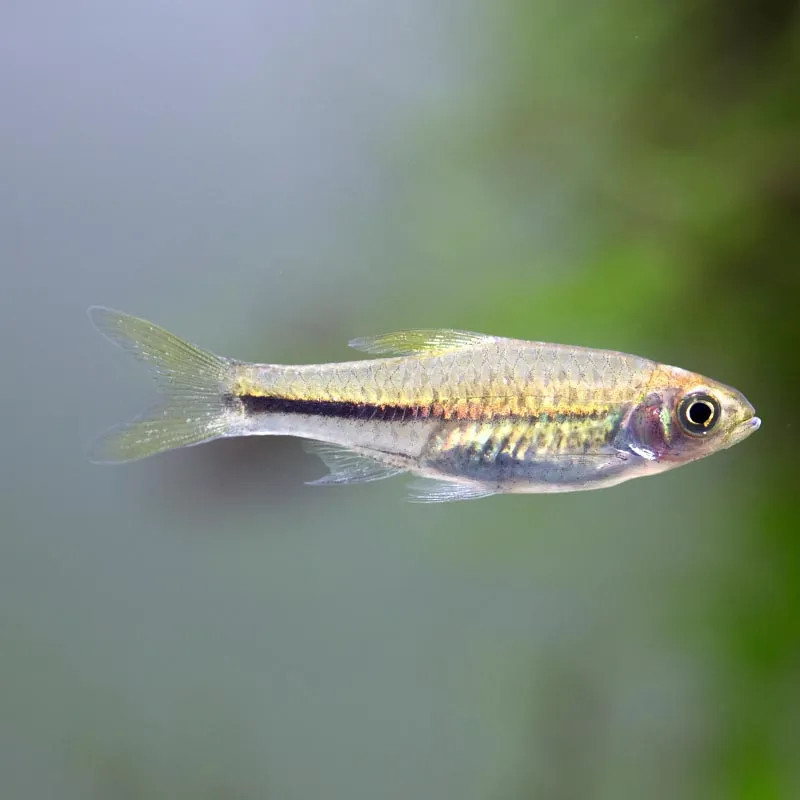Stocks Available
BLACK HARLEQUIN
SKU:118928
TRIGONOSTIGMA HETEROMORPHA
2.5 CM

Stock Available
Introduction: Species: Rasbora trilineata Common Names: Scissortail Rasbora, Three-Line Rasbora Natural Habitat: Native to the freshwater rivers and streams of Southeast Asia, particularly found in the clear waters of Thailand, Myanmar, and Malaysia. They typically inhabit areas with dense vegetation and submerged plants. Physical Characteristics: Appearance: The Scissortail Rasbora features a slender, elongated body with a distinctive coloration. They have a silvery to light gold body adorned with three prominent black stripes that run along the lateral line, giving them a striking appearance. The tail fin is forked and may display vibrant orange or red hues, particularly in well-conditioned individuals. Size: Grows to about 2-3 inches (5-7.5 cm) in length. Lifespan: Typically lives for 3-5 years with proper care. Habitat Requirements: Tank Size: A minimum of 15 gallons is recommended for a small group; larger tanks are preferable to allow for adequate swimming space. Water Conditions: Temperature: 72-78°F (22-26°C). pH: 6.0-7.5 (slightly acidic to neutral). Hardness: Soft to moderately hard water (5-15 dGH). Aquascaping: Provide plenty of open swimming space along with densely planted areas using live plants, driftwood, and rocks to mimic their natural environment. Diet: Primary Diet: Omnivorous; in the wild, they feed on small insects, crustaceans, and plant matter. Supplemental Feeding: In captivity, offer high-quality flakes or pellets, supplemented with live or frozen foods such as daphnia, brine shrimp, and bloodworms. Feeding Frequency: Feed small portions 1-2 times a day for optimal health, ensuring that uneaten food is removed to maintain water quality. Compatibility: Temperament: Generally peaceful and social; best kept in groups of 6 or more to promote natural schooling behavior. Suitable Tank Mates: Compatible with other peaceful community fish of similar size, such as Tetras, Rasboras, and smaller Gouramis. Incompatibilities: Avoid aggressive or fin-nipping species that may stress or harm the Scissortail Rasboras. Care Level: Difficulty: Moderate; requires stable water parameters and regular maintenance to thrive. Health Monitoring: Monitor for signs of disease, especially stress-related issues and common parasites. Maintaining good water quality is essential for their overall health. Breeding: Breeding in Captivity: Breeding is possible in captivity under suitable conditions; however, they may require specific setups for successful spawning. Spawning: They are egg scatterers and will lay eggs among fine-leaved plants. Parental care is minimal, so it is advisable to provide dense vegetation or spawning mops to protect the eggs. Economic Considerations: Market Demand: There is a steady demand for Scissortail Rasboras among freshwater aquarium enthusiasts due to their peaceful nature and attractive appearance. Wholesale/Retail Pricing: Prices can vary, but they are generally affordable and readily available in the aquarium trade. Sustainability and Conservation: Wild Population: While not currently endangered, populations may face pressures from habitat destruction and pollution. Aquaculture Efforts: Increasingly bred in captivity to reduce reliance on wild populations and promote sustainable practices. Regulations: Compliance with local and international regulations concerning the trade of freshwater fish is essential for conservation. Conclusion: The Scissortail Rasbora is a vibrant and dynamic addition to freshwater aquariums, valued for its striking coloration and peaceful nature. Their care requirements and schooling behavior make them suitable for both novice and experienced aquarists. With proper care and attention to their habitat and dietary needs, Scissortail Rasboras can thrive, adding beauty and liveliness to any aquarium setting.
Data sheet
4 other products in the same category: